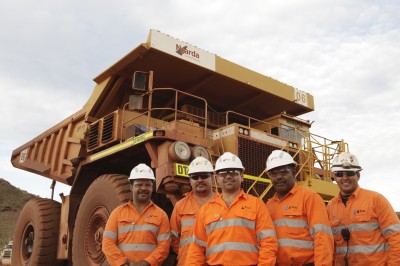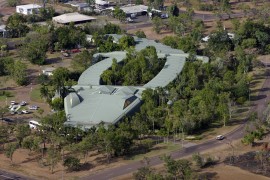
Innovative way to measure what matters
Indigenous Business Australia with SVA Consulting have developed an affordable, transparent and objective system that measures social impact and is helping management make appropriate and time

- With some innovative thinking, Indigenous Business Australia (IBA) and SVA Consulting have developed a simple framework and process, based on SROI principles, to measure and evaluate social impact.
- The resulting ‘Indigenous Economic Impact Reports’ provide IBA with regular and consistent data which helps decision-making to improve performance in line with strategic objectives.
The business world has long believed that you should measure what matters. Almost all organisations regularly measure and report on their financial outcomes. Yet relatively few organisations regularly measure and report on their social outcomes. Financial reports contain rich information that tell management how much profit a business is making, how much cash it has, how strong its balance sheet is and how these and many other indicators have changed over time.
For organisations that seek to create both financial and social impact, the challenge is to design frameworks that also measure and evaluate social impact on a regular basis.
Indigenous Business Australia (IBA) achieves not only financial outcomes but other beneficial impact on Indigenous people and organisations, and it wanted to measure both.
With previous attempts behind it, IBA knew what it wanted to measure, and engaged SVA Consulting to help create a framework that would achieve this.
Understanding IBA’s role as an ‘impact investor’
IBA’s vision is that of a nation in which the First Australians are economically independent and an integral part of the economy. IBA began in 1990 as the Aboriginal and Torres Strait Islander Commercial Development Corporation (CDC) which aimed to promote self-management and self-sufficiency and build wealth for Indigenous organisations. By 2012, IBA’s Equity and Investment Program’s portfolio had around 30 investments worth over $300m.
IBA has traditionally been a commercial investor creating positive impact on Indigenous people by generating stable and enduring income streams and supporting wealth accumulation for its Indigenous equity partners. The commercial focus has been important to distinguish IBA from welfare-based Indigenous programs. Since 2010, IBA has been keen to better articulate its other impact on Indigenous Australians and now describes itself as a ‘financial first impact investor’[i]. This reflects both that the investments directly impact the Indigenous people who live and work in the local communities where the investments are located, and IBA’s purpose as described in its founding legislation[ii].
What is impact investing?
‘Impact investments are investments made into companies, organizations, and funds with the intention to generate measurable social and environmental impact alongside a financial return.’
Whilst IBA’s investments must be financially sustainable, they can also carry social and cultural significance and support better governance, health and wellbeing for the community.

The investments can provide opportunities for employment and training for Indigenous people and supply chain benefits for Indigenous-owned businesses. For example, one of IBA’s industrial investments has employed and trained hundreds of Indigenous people in addition to generating income for a local Indigenous equity partner organisation.
IBA was after more than anecdotal evidence that its investments were creating more than just wealth for equity owners. It wanted to know how much impact it was having on the Indigenous communities in which the investments were located. And it wanted the data that would help it improve and have more impact.
We believed that measuring impact would shed light on what worked and what did not so that we could improve investment decision-making…
Through 2011 and 2012, IBA explored various impact measurement methodologies but found that they were complex and cumbersome to implement. According to General Manager Investments, Rajiv Viswanathan, the results were difficult to communicate and did not appear to inform decision-making.

Wanting to send a clear message to staff and partners about its commitment to improving outcomes for its Indigenous stakeholders more broadly and to better understand the benefits that IBA’s investments were providing for Indigenous Australians, Viswanathan remained intent on finding a solution.
“We believed that measuring impact would shed light on what worked and what did not so that we could improve investment decision-making, collaborate more effectively with partner organisations and ultimately improve both financial returns and beneficial impact through our investments,” says Viswanathan
Obstacles to developing a measurement system
IBA’s early exploration with measurement methods helped it get clear about what it wanted to do and what it didn’t want to do. So, when SVA Consulting began working with IBA, Viswanathan knew that the new framework needed to deliver results that were credible, transparent and verifiable. Simplicity was also essential as the framework needed to be replicated regularly across a portfolio of 30 investments around Australia.
However, even with a strong focus on simplicity and credibility, there were still challenges in developing the system.
Concern about the perceived subjectivity of measuring social impact
Most of IBA’s Equity and Investment Program staff had commercial backgrounds and a strong preference for objective and verifiable data. Therefore it was important to demonstrate that impact measurement was not subjective, but based on hard data that could provide useful insights into asset management.
Lack of dedicated resources for measuring social impact
IBA’s Equity and Investments Program did not have someone with dedicated responsibility for measuring social impact. During prior attempts, the task had fallen generally to staff who did not have sufficient time for the data collection, analysis and reporting.
Other measurement methodologies did not suit the IBA context
It was important that lessons learned from earlier attempts were incorporated into the new framework to produce a workable solution.
The process also needed to bring staff on the journey so that they would not only understand the framework’s purpose, but support the process and use the results to inform decision-making.
How the simple framework was developed
IBA credits much of the project’s success to SVA Consulting’s approach which was grounded on three principles:
- Keep it simple – so that the framework could be used frequently across a large number of investments
- Collaborate, collaborate, collaborate – so that staff would understand and use the framework
- Measure what matters – support IBA’s Equity and Investments Program to measure the outcomes that are integral to its core purpose.
…the primary objective was to understand what was happening on the ground in order to enhance investment decisions and portfolio management.
These principles underpinned the project which consisted of four phases: Getting on the same page; Designing the framework; Building and piloting the framework; and Embedding the framework. Representatives from IBA and SVA Consulting worked together through the four phases.
Phase 1 – Getting on the same page
Before the project started, Viswanathan had clearly communicated that IBA would measure social impact. At the initial workshop, staff agreed that the primary objective was to understand what was happening on the ground in order to enhance investment decisions and portfolio management. And that this would lead to greater overall impact. Everyone also reiterated that it was critical that the framework be simple and credible.
Measuring what matters
IBA agreed that this initial framework would be a pilot; it would start measuring four outcomes each quarter and expand later if it worked well and seemed necessary.
As IBA’s Senior Manager, Tom Jenkins says “We selected the four outcomes where we thought we had direct impact and that improvement could be achieved”. These were:
- Financial returns to Indigenous partners
- Indigenous employment
- Indigenous training
- Procurement from Indigenous-owned suppliers.
Previously, IBA had considered a full Social Return on Investment (SROI) analysis but realised that it would only provide a snapshot and was more costly for frequent use. However it did like many of the SROI concepts and decided to develop its framework using five of the SROI principles.[iii]

- Understand what changes
- Value what matters
- Only include what is material
- Do not over-claim
- Be transparent.
The principle of ‘involve stakeholders’ was omitted as it would be time-consuming to regularly engage a large number of managers, employees and suppliers. ‘Verify the result’ was not needed as the framework is primarily for internal management reporting. For external communication purposes, IBA could seek independent verification at a later stage if required.
Phase 2 – Designing the framework
A single methodology was developed to apply to each outcome area. This made it easier to use and the results easier to interpret. The methodology has four steps:
- What changed – Identify what changed during the relevant reporting period
- Deadweight – Establish the ‘deadweight’ (what would have happened anyway without IBA’s program)
- Attribution – Establish IBA’s ‘attribution’ (how much of the outcome was caused by IBA’s contribution)
- Financial proxy – Assign a financial value.
Defining the indicators
The team developed indicators for each outcome area, focusing on the incremental financial benefit to Indigenous people or organisations resulting from IBA’s contribution. SVA Consulting suggested that IBA look more closely at the economic impact than simply the number of Indigenous employees as an absolute total and as a proportion of total headcount in the investments. Instead, IBA could measure the average gross salary paid to Indigenous employees in each investment and then work out how much they would have been paid anyway and what proportion was IBA’s contribution. This would tell IBA a lot more than just headcount.
Estimating deadweight
To avoid having to ask stakeholders directly, the team developed standard deadweight measures that it believed were good approximations of what would have happened anyway. In making all of the deadweight assumptions, the team strove for simplicity, while also ensuring the results would be objective and transparent. The assumptions called for reliable external data which were sourced from the Australian Bureau of Statistics and the Reserve Bank of Australia. The methods meant the data could be independently verified if IBA chose to do so in the future.
Establishing attribution and calculating financial value
The team also established a clear framework for attribution (how much of the outcome was caused by IBA) and for assigning financial proxies to outcomes.
SVA Consulting refined the reports until IBA was happy that they contained the right level of detail and were the right format for decision-making…
To complement the financial indicators, the team would also identify whether investments had formal policies that might be good lead indicators of future outcomes such as Reconciliation Action Plans and formal Indigenous employment, training and procurement policies.
Phase 3 – Building and piloting the framework
Once the methodology was agreed, SVA Consulting built a mock-up of the final reports to share with the IBA Equity and Investments Program staff who would provide input and use the reports. Three reports were developed: one for an individual investment, one for each sector (IBA invests in four sectors) and one for the overall portfolio. SVA Consulting refined the reports until IBA was happy that they contained the right level of detail and were the right format for decision-making.
SVA Consulting then built a model in Excel for data collection and analysis that was easy to modify and demonstrated to staff how the model worked. This level of transparency helped ensure staff support. There were no magic buttons or clever mathematics; everything was based on simple arithmetic so anyone could follow the process from data inputs through to final results.
The team then piloted the model using data provided by the portfolio managers of six of the investments. The reports from this initial pilot were shared with internal stakeholders.
Phase 4 – Embedding the framework
The stakeholders’ overwhelming response was that the framework was useful, generated many insights and would inform their decision-making. Most importantly, IBA saw that it was simple to use and understand and would be credible enough for internal decision-making and eventually for external communication about impact. IBA named the reports ‘Indigenous Economic Impact Reports’ and decided to roll them out for all the investments. SVA Consulting supported the implementation process and continues to provide support on a regular basis.
From measurement to impact
Eighteen months on, the framework has enabled IBA to develop a clear picture of where it has a positive impact and where it needs to improve. As Jenkins says “measuring impact is now core business”.
Now IBA learns more about its investments every quarter and can respond quickly to big changes.
IBA resourced itself properly to do this and established a sustainability team to report directly to Viswanathan. This team is accountable for measuring social impact and for developing and implementing plans for enhancing impact.
Developing a more nuanced understanding of employment outcomes
IBA is able to use the reports to better understand the employment situation in its investments. The reports help IBA to ask the right questions to find out what employment opportunities are provided, whether there are high-level opportunities that are being missed, whether it can better target recruitment and training and how it can build more employment pathways by linking in to other organisations and programs in local communities.
Accessing timely information about changes
The results show trends within and across the investment portfolio’s sectors and over time. Now IBA learns more about its investments every quarter and can respond quickly to big changes.
Articulating expectations and aligning incentives
IBA partners with industry expert organisations that manage the investments and are often also equity investors in the investments. The framework helps IBA articulate its expectations to these partners.

For example, when IBA showed the first Indigenous Economic Impact Report to one if its private sector partners, it was able to set expectations that the firm should ensure Indigenous financial returns, employment, training and procurement outcomes. As Jenkins says, “the report helps us articulate our expectations to partners and this leads to more commitment from them”.
IBA is also negotiating contracts that provide incentives for these partners to create more impact from the investments. For example, IBA has recently engaged a national provider to manage its entire commercial property portfolio, as part of which IBA has secured commitments to work collaboratively to pursue Indigenous economic outcomes from the portfolio.
Informing future acquisitions
The Indigenous Economic Impact Reports provide IBA with useful information for when it performs due diligence on a potential investment. By understanding what impact occurs in existing investments, IBA can better predict what is possible in potential assets, thus ensuring investment decisions are based on due diligence of both financial and social impact.
Developing new impact strategies
The portfolio managers are enthusiastic about the system as it provides another perspective on the performance of the assets they manage. They are now engaged in a three-part, closed loop process of setting targets, implementing strategies to achieve those targets and then measuring. This feedback process enables them to learn from what they are doing. At this point they are developing strategic investment plans for each sector with explicit economic impact goals and plans for how to achieve these goals.
Driving social impact is now embedded as a part of how IBA’s Equity and Investments Program does business.
Importantly, IBA plans to collaboratively develop an Aboriginal engagement strategy with all of its managed investments. This uses information from the reports to help the investee increase its economic and social outcomes. Jenkins says that this approach “has also built trust between IBA and its Indigenous partners because we are demonstrating that we care about the same things that they care about”.
Overall, the Indigenous Economic Impact Reports provide IBA with a deeper understanding of what is going on at an investment, sector and portfolio level. The process is seen as a sustainable and useful measurement and evaluation framework. Driving social impact is now embedded in how IBA’s Equity and Investments Program does business.
Lessons learned and thoughts for the future
According to Jenkins, the most significant result of the project is that the act of identifying and measuring the right outcomes aligned with our goals demonstrated to staff the importance of these outcomes. “This resulted in changes from a focus on financial performance to a more holistic view of asset performance and measurement communicates this change very clearly.”
“As a result, our investments are generally achieving improved outcomes; staff members are better aligned with the concept of IBA as a financial first impact investor and this all occurred not through analysis of the reports, but because of the act of measuring the things that mattered,” says Jenkins.
Many non-profits, social enterprises, impact investors and corporates seek to achieve social impact but shy away from measuring that impact fearing that it is too expensive, too subjective or too difficult. Together, IBA and SVA Consulting have developed an innovative framework that is affordable, transparent, objective, repeatable, verifiable and, most importantly, useful.
IBA’s framework is not a ‘measurement tool in a box’, but the process and methodology might prove a valuable template for how to make measuring and evaluating social impact more accessible and, ultimately, more useful.
Author: Suzie Riddell
[i] ‘Financial first investors seek to optimize financial returns with a floor for social or environmental impact. They are typically commercial investors who seek out subsectors that offer market-rate returns while achieving some social or environmental good.’ Investing for Social and Environmental Impact Report, Monitor Institute.
[ii] IBA’s founding legislation states that it must “act in accordance with sound principles” and promote…”commercial and economic activities that are likely to have beneficial impact on Aboriginal or Torres Strait Islander interests”.
[iii] The two principles not used were: ‘Involve stakeholders‘ and ‘Verify the result’.





